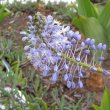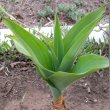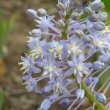Merwilla plumbea
| Botanical Name | Merwilla plumbea |
|||||||||||||||||||||
| Family | Hyacinthaceae - The hyacinth family. |
|||||||||||||||||||||
| Pronunciation | mer-WIL-luh plum-BEY-uh |
|||||||||||||||||||||
| Common Name(s) |
English: Wild squill; Blue squill; Blue hyacinth
Afrikaans: Blouberglelie; Blouslangkop
IsiXhosa: ugontsana; umasixabane
IsiZulu: Inguduza
Sesotho: kgerere
Sesotho sa Leboa: ichita
|
|||||||||||||||||||||
| Plant Group |
|
|||||||||||||||||||||
| Plant Size |
|
|||||||||||||||||||||
| Position |
|
|||||||||||||||||||||
| General Information |
|
|||||||||||||||||||||
| Specific Information | Merwilla plumbea, previously known as Scilla natalensis, is a deciduous bulb, much of the upper part of which is usually above ground. The bulbs are relatively large (10 - 15 cm in diameter) and are covered with protective, dry, brown to purplish scales, reminiscent of an onion. The broad tapering leaves emerge in spring, before or after flowering, in an attractive rosette and are very variable:
Leaves are shed in autumn but may remain evergreen if well watered. The plant will tolerate winter rain if well-drained, preferably planted on a slope, but will die if heavily frosted. Bees pollinate the flowers which become honey scented in the evening. The seeds are formed in capsules that split when dry and are dispersed by the wind. Merwilla plumbea is a very popular item in the KwaZulu-Natal muthi trade and intensive harvesting over an ever-increasing area of its distribution range is causing a marked decline in wild populations. As a result, it's Red Data conservation status has recently been upgraded Vulnerable. This bulb should be planted with discretion as it is toxic to humans and some animals and can be fatal if any part of it is eaten. |
|||||||||||||||||||||
| Ad Break | ||||||||||||||||||||||
| Flowers | ||||||||||||||||||||||
| Description | many small, star-shaped flowers, 10 mm in diameter, clustered at the end of a single erect stem of 75 cm to over a meter long |
|||||||||||||||||||||
| Season |
|
|||||||||||||||||||||
| Colour |
|
|||||||||||||||||||||
| Growth Rate |
|
|||||||||||||||||||||
| Plant Uses |
|
|||||||||||||||||||||
| Distribution and Habitat | in the provinces of the Eastern Cape, KwaZulu-Natal, Free State and Mpumalanga, as well as in Swaziland and Lesotho, solitary or in groups, in grasslands, highland mist belt , steep, sunny, well drained slopes, rocky hills, damp cliff faces, near waterfalls, in moist depressions, and on the edges of streams and vleis. |
|||||||||||||||||||||
| Planting Suggestions | The bulbs should be planted with at least two-thirds to one half of the bulb above ground in good, well-drained soil enriched with compost. Best planting time is in late winter to early spring. Keep a good layer of mulch around them throughout the year to retain moisture and enrich the soil. A sprinkle of slow release organic fertiliser can be applied every now and then. They are relatively tolerant of drought but water well during the summer months for best results. Withhold water in late summer as the leaves begin to yellow and keep them dry during winter. Resume watering in spring. They are reportedly able to survive the winter rains of the Western Cape as long as the soil is very well drained and more so if planted in sloping ground. If the climate is severely cold in winter they should be grown in containers that can be stored indoors during winter. The plant grows easily from seed but these must be absolutely fresh - plant straight after collection and will take 4-7 years before they mature. Merwilla plumbea resents being disturbed and may not flower for a season or two after being moved. If left undisturbed for a few years, the bulb will develop into a clump. This can be lifted and divided during winter but if possible, rather remove only the outer bulbs so that the mother plant can remain undisturbed. |
|||||||||||||||||||||
| Lorraine's Garden Notes | ||||||||||||||||||||||
| Medicinal Uses | Merwilla plumbea is used extensively as a medicinal plant. Warmed fresh bulb scales, slightly burned bulb scales, ash from the burned plant and decoctions of the bulb are used in various ways as ointments for wound-healing, to treat sprains, fractures, boils and sores, to draw abscesses, for female infertility, to enhance male potency and libido, as a purgative, a laxative, for enemas, for internal tumours, chest pain and kidney troubles as well as an ingredient for the treatment of lung disease in cattle. In some areas the powdered bulb is rubbed into the back, joints and other body parts to increase strength and resistance to witchcraft. This plant should be treated with extreme caution, as taking any part of it internally is potentially fatal. Use only under the guidance of an experienced traditional healer. |
|||||||||||||||||||||
| Ad Break | ||||||||||||||||||||||







Comments
Merwilla Plumbea
I recently acquired Scilla Peruviana (having been told it was indigenous) and then found a Merwilla as well. I have not yet planted the bulb and am encouraged to hear that it is poisonous since a cape dune mole has arrived in my garden. Does this mean the mole will not eat it?
I have no idea what to do and where to go with the many special and beautiful indigenous bulbs I also acquired this past summer. Any suggestions on how I can protect them?
I live in Paternoster next to the ocean where gardening is a real challenge. I have made peace with golden moles but my garden can hardly cope with a dune mole onslaught. I am particularly concerned about cone bushes and proteas that have finally been established.
Will Mole Rats eat Merwilla plumbea?
Hi Deirdre
First off, it is best to know exactly what you are dealing with. Go to: http://kumbulanursery.co.za/blog/the-truth-about-moles.
I don't know if Mole Rats will eat Merwilla plumbea. Clivia and Scadoxus are also toxic but the Mole Rats cause devastation to Clivia and eat the roots and nibble on the bulbs of my Scadoxus. Boophone and Brunsvigia reportedly contain particular a chemical that protects them from Mole Rats. According to PlantZAfrica, Merwilla, although deadly to humans, is 'selectively toxic to mammals', and 'has been proven an ineffective rat poison'.
When, after long desiring these bulbs, I got some, I was unwilling to take a chance and planted them safely in a protected environment in which I now grow many of my most precious and at risk bulbs. See image. I begged and bought plastic baths from people renovating or from second-hand shops, drilled lots of drainage holes, sank them into the soil, put in a layer of gravel and filled them with soil. They are rather unsightly so I attempt to hide the edges and the system works pretty well.
I have tried orange bags and shade netting bags which worked until the bulbs outgrew them - although the Mole rats did manage to chew through them as well. You can make cages out of fine chicken wire, but this rusts and rots under the ground quite quickly. I also thought of using a crate with very small spaces in the base and lined with strong netting, but didn't it try out as I decided on the baths being more suitable.
I don't think you need worry about the Protea family. I have never had a problem with them - Mole rats like juicy roots and bulbs.
In my garden they have gone through Albuca (they love these), Clivia, Cyrtanthus (another favourite), Drimiopsis, Ledbouria, some gladiolus, Haemanthus, Nerine, Ornithogalum, Scadoxus, Tulbaghia (decimated), Sparaxis, some Watsonias and Urginia, as well as carrots and beetroot.
They have not eaten Boophone, Brunsvigia. Veltheimia, Eucomis, Amaryllis, Crinum or Hypoxis.
Although I can't answer your question, I hope this is of some help.
Kind regards
Lorraine
Mervilla Plumbea
Where can I get some of these bulbs?
Bulb availability
Hi Minda
Apologies for the tardy reply.
Click on 'Shire Wild Bulb Nursery' on the right of this page, under the heading 'You may also be interested in'.
This is where I got mine from.
Kind regards
Lorraine
Discuss this plant
Share knowledge, ask a question or give an experience.